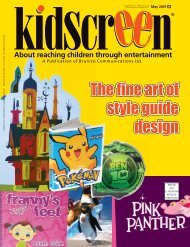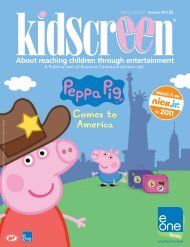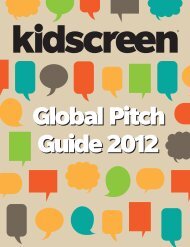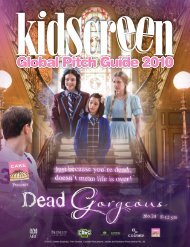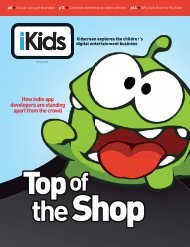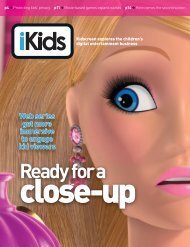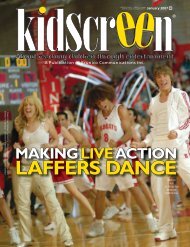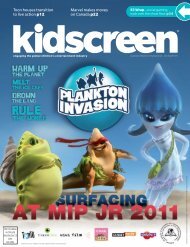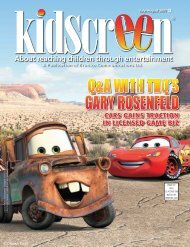rs ANIMATION SECIVRES CONTENTS - Kidscreen
rs ANIMATION SECIVRES CONTENTS - Kidscreen
rs ANIMATION SECIVRES CONTENTS - Kidscreen
You also want an ePaper? Increase the reach of your titles
YUMPU automatically turns print PDFs into web optimized ePapers that Google loves.
MIXED<br />
MEDIA<br />
30<br />
2D characte<strong>rs</strong> are fi rmly grounded in the “real” town of Elmore in The Amazing World of Gumball<br />
a 52 x seven-minute series based on artwork<br />
made from salvaged beach objects<br />
like shells, pieces of glass, metal and bits<br />
of wood. Driftwood Bay imports photos of<br />
characte<strong>rs</strong> and props assembled from objects<br />
found on a local beach into 2D animation<br />
that’s juxtaposed against photographic<br />
and watercolor backgrounds.<br />
“The art was so strong and beautiful, so<br />
it was natural to develop the idea of a girl<br />
living on the shore and fi nding stuff that<br />
sparks adventures taking her to imaginary<br />
places where everything is made from stuff<br />
found on the beach,” says Williams.<br />
Sticking to the artistic visual purity of<br />
the show meant developing a painstaking<br />
process of photographing every piece<br />
of beach salvage—about 25 tiny pieces<br />
in one character alone—to build the animated<br />
models. The process ends up giving the fi nished product<br />
a stop-motion feel, though it’s made using 2D CelAction<br />
software. On many occasions, the team completely redesigned<br />
characte<strong>rs</strong> with rounder stones and objects when Williams realized<br />
that although they looked good in static head-on shots,<br />
when they turned to the side, the characte<strong>rs</strong> looked like fl at<br />
stacks of pancakes.<br />
NOW MAKE IT HAPPEN<br />
A show concept with an arresting visual look—along with<br />
great comedic appeal—also caught the interest of Cartoon<br />
Network when it took internal pitches as part of its nascent<br />
development initiative in 2007. The Amazing World of Gumball<br />
was born from a pitch made by Ben Bocquelet, an in-house<br />
animator with a background in commercial work honed at<br />
London-based commercial production studio Passion Pictures.<br />
The pitch was a funny idea about the misadventures of<br />
12-year-old cat Gumball and a slew of mismatched characte<strong>rs</strong><br />
that combine 2D and CGI animation dropped onto a photoreal<br />
background.<br />
Though the bulk of the creative development and mixed-media<br />
animation was done in-house (with animation and compositing<br />
outsourced to Studio Soi in Germany and Ireland’s Boulder<br />
media in the fi <strong>rs</strong>t series), it’s worth noting the creative problemsolving<br />
and extreme attention to detail that went into creating<br />
Gumball’s world.<br />
Central to the show’s conceipt was that its main setting,<br />
Elmore, had to look like a real town where it seemed plausible<br />
that this melee of characte<strong>rs</strong> could actually live. The<br />
series art director, Antoine Perez, says it took several experiments,<br />
in which the background plates were manipulated<br />
via Photoshop to get the look just right. And here’s where<br />
things get technical.<br />
“The brain has to be tricked into thinking that it’s looking at<br />
the real world and it can unconsciously pick up on minor pe<strong>rs</strong>pective<br />
mishaps,” says Perez. “The solution is to fi lm the back-<br />
KIDSCREEN’S <strong>ANIMATION</strong> SERVICES ISSUE 2012<br />
ground plate through a virtual camera, even if it’s not moving.<br />
You can then make the virtual camera zoom in, look left or right,<br />
and the pe<strong>rs</strong>pective will respond realistically.”<br />
Perez also explains that having a solid pre-visualized plan<br />
for each episode was key in cutting down the number of retakes<br />
needed to mesh the different styles together. Once that<br />
was nailed down, he says the 2D, CGI and background work<br />
was done simultaneously.<br />
TRICKS OF THE TRADE<br />
Managing different production pipelines simultaneously and<br />
then bringing everything together at the end is just what Manchester,<br />
England-based Impossible Kids is trying to accomplish<br />
for its new live-action show in development, Animatter. The series<br />
is about kids who can transform into beastly creatures via<br />
a rogue military device, and it incorporates about two minutes<br />
of animated footage per ep. This animation features comical<br />
monste<strong>rs</strong> with over-the-top pe<strong>rs</strong>onalities that are depicted using<br />
dynamic camera angles, à la The Mask. Scripts and creature<br />
design will be done in the UK, and live-action casting and fi lming<br />
carried out in Canada. Impossible Kids selected Australia’s<br />
Ambience Entertainment to produce the animation with liveaction<br />
footage.<br />
“Their tracking tests blew me away,” says Impossible Kids<br />
creative director Jon Doyle. “It looks like someone has swung a<br />
hand-held camera around to a CGI creature and they are just<br />
pointing the camera around at this thing.”<br />
Doyle adds that the prodco went with Ambience based on<br />
its track record of animating comical creatures, (as in series<br />
like Erky Perky), in a way that keeps the character shots more<br />
funny than scary for younger viewe<strong>rs</strong>. To streamline the process,<br />
a team from Australia will travel to Canada for the live-action<br />
shoots to collect data to create animatics. The animation will be<br />
locked onto the live-action plates in Australia and then shipped<br />
back to the UK, to cut down on the compositing and post-production<br />
phase in London.








